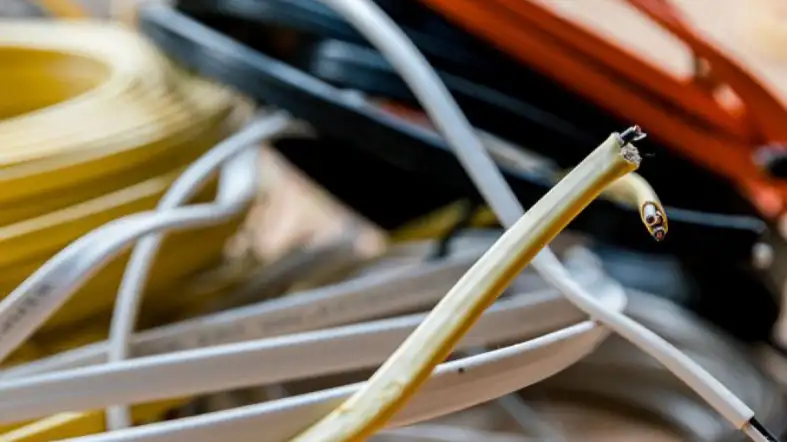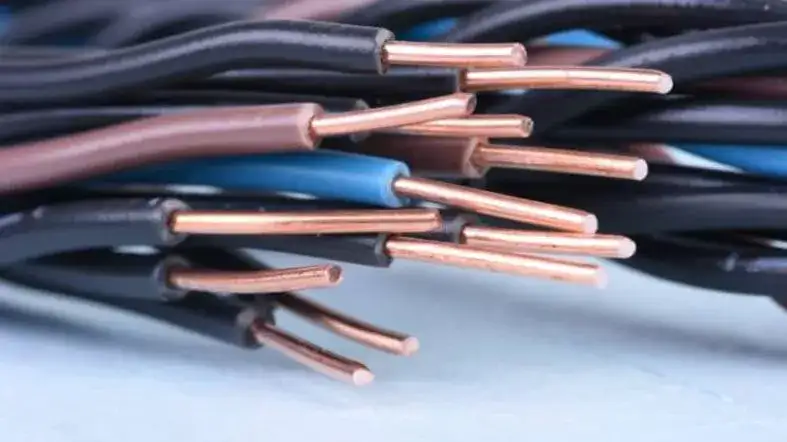Choosing the correct wire size for a 220V AC unit is crucial for ensuring safe and efficient operation and avoiding overheating and potential fire hazards. if you are in search of What Size Wire For 220V AC Unit, read on.
This article will guide you through the process of determining the right wire size, exploring various types, and discussing the installation process.

What Size Wire Do I Require For A 220V AC Unit?
For a 220V AC unit, typically, a 12-gauge wire is sufficient for units with a current draw of 20 amps or less. However, the exact wire size for a 220V AC unit depends on the amount of AMP draw, distance and load can affect the appropriate wire size.
220V AC Unit Wire Size Chart:
| Air Conditioner Size | Amp Draw At 220V | Wire Size |
|---|---|---|
| 2.5 Ton | 13.64 Amps | 14 AWG Wire |
| 3 Ton | 16.36 Amps | 12 AWG Wire |
| 3.5 Ton | 19.09 Amps | 12 AWG Wire |
| 4 Ton | 21.82 Amps | 10 AWG Wire |
| 4.5 Ton | 24.55 Amps | 10 AWG Wire |
| 5 Ton | 27.27 Amps | 10 AWG Wire |
Types of Wire for 220V AC Units
When it comes to wiring a 220V AC unit, choosing the right type of wire is crucial for ensuring safety and reliable operation.
Here are some of the most commonly used types of wire for 220V AC units:
Copper Wire
Copper is a popular choice for wiring due to its high conductivity and corrosion resistance. It is commonly used for both residential and commercial AC unit installations.
Aluminum Wire
Aluminum is a cheaper alternative to copper, but it has lower conductivity and is prone to corrosion. It is not recommended for use in AC unit installations unless the wiring is properly treated to prevent corrosion.
THHN Wire
Thermoplastic High Heat-Resistant Nylon (THHN) wire is a popular choice for AC unit wiring due to its high temperature and moisture resistance.
It is commonly used in both indoor and outdoor installations.
UF-B Wire
Underground Feeder (UF-B) wire is specifically designed for use in underground applications.
It has a tough outer sheath that protects against moisture and can be used in direct burial applications.
MC Cable
Metal-Clad (MC) cable is a type of armored cable that is commonly used in commercial and industrial AC unit installations.
It has a metal sheath that provides extra protection against damage.
BX Cable
BX cable is an older type of armored cable that is not commonly used for AC unit installations anymore.
It has a metal sheath that provides some protection against damage, but it is not as durable as MC cable.
How To Calculate The Right Size Wire For 220V AC Unit?

Choosing the right size wire is critical for ensuring that your 220V AC unit operates safely and efficiently. Here are the steps to calculate the right size wire for your unit.
Step 1: Determine the Required Amperage
Before you can choose the right wire size, you need to determine the amperage required by your 220V AC unit.
Check the manufacturer’s specifications or consult a licensed electrician to determine the amperage.
Step 2: Calculate the Voltage
Drop Voltage drop occurs when electrical current flows through a wire, causing a reduction in voltage.
To calculate voltage drop, you need to consider the length of the wire, the amperage, and the wire gauge.
You can use online calculators or consult an electrician for this calculation.
Step 3: Choose the Right Wire Size
Based on the amperage and voltage drop, you can choose the right wire size.
Choose a wire size that can handle the current and voltage requirements of your 220V AC unit.
Larger wire sizes have less resistance and can handle higher current loads, which reduces the risk of overheating and other electrical issues.
Step 4: Consider Other Factors
In addition to amperage, voltage drop, and wire size, there are other factors to consider when choosing the right wire for your 220V AC unit.
These include the type of wire insulation, the temperature rating of the wire, and any local codes or regulations that may apply.
Step 5: Consult a Professional
If you’re not confident in your ability to calculate the right size wire for your 220V AC unit, or if you’re unsure about any of the other factors involved, consult a licensed electrician.
A professional can ensure that your wiring is safe, up to code, and appropriate for your specific application.
How To determine the Factors Of Wire Sizing For A 220V AC Unit?

Choosing the right wire size is essential for ensuring that your 220V AC unit functions properly and safely.
Here are the factors that you should consider when sizing wires for your 220V AC unit.
Voltage and Amperage
To determine the correct wire size, you need to know the voltage and amperage of your 220V AC unit.
The amperage requirement varies based on the size and type of the unit, and it can be found in the unit’s manual or by consulting a licensed electrician.
Voltage Drop
Voltage drop is the reduction in voltage that occurs when current flows through a wire. It can lead to decreased performance and safety issues.
You need to calculate the voltage drop based on the length of the wire, the amperage, and the wire gauge.
You can use online calculators or consult an electrician for this calculation.
Wire Insulation
The wire insulation material is another factor to consider.
The type of insulation affects the wire’s ability to withstand temperature changes, moisture, and exposure to chemicals.
Different insulation types have different temperature ratings, and you should select a type that can withstand the expected operating temperature.
Local Codes and Regulations
Local codes and regulations can also affect the wire size selection.
It’s important to check with the local authorities to make sure that the wire size meets the required specifications.
Wire Size
The wire size is critical for ensuring that it can handle the required amperage without overheating or causing other electrical problems.
Larger wire sizes have less resistance and can handle higher current loads, reducing the risk of overheating and other issues.
Installation Tips for 220V AC Unit Wiring
Wiring a 220V AC unit can be a challenging task, but with the right tools and knowledge, you can do it safely and effectively.
Here are some detailed installation tips to help you get the job done right:
Step 1: Turn off the Power
Before beginning any electrical work, always turn off the power to the circuit at the main breaker.
Use a voltage tester to confirm that the power is off before proceeding with the installation.
Step 2: Choose the Correct Wire Gauge
Choosing the correct wire gauge is crucial to ensure that the wiring can handle the amperage load of the AC unit.
Refer to the manufacturer’s specifications and local electrical codes for the recommended wire size.
The wire gauge will determine the maximum amperage that the wire can handle, and choose a wire that can handle the load of the AC unit to avoid overheating or damage to the wire.
Step 3: Use the Proper Connectors
Use connectors that are rated for the wire size and amperage load of the AC unit to ensure a secure and safe connection.
Wire nuts, crimp connectors, and terminal blocks are all suitable connectors, but make sure to use the correct size and type of connector for your wire.
Step 4: Secure Wires Properly
Use cable ties or clamps to secure wires and prevent them from coming loose or getting damaged.
Wires should be secured at regular intervals to ensure that they are not subject to excessive movement or strain.
Step 5: Use the Appropriate Conduit
If required by local electrical codes, use appropriate conduit to protect the wiring from damage and ensure a safe installation.
Conduit can be made from PVC, metal, or flexible materials and is available in various sizes and types.
Always choose a conduit that is rated for the amperage and voltage of your AC unit.
Step 6: Label Wires
Label wires with their corresponding circuit and components to make future troubleshooting and maintenance easier.
Use permanent markers or labels to clearly identify each wire and its function.
Step 7: Test Connections
After completing the installation, test all connections and circuits to ensure that they are working properly.
Use a multimeter or voltage tester to verify that the correct voltage is present at each connection point and that there are no shorts or open circuits.
FAQs About The Right Size Wire For 220V AC Unit
What Type Of Wire Do I Need For A 220v AC Unit?
Air conditioner circuits are typically connected with a nonmetallic wire. The wire gauge must be suitable for the circuit’s amperage. While circuit breakers are intended to manage this surge, air conditioners will occasionally trip a circuit breaker during the start-up surge.
Can A 2.5mm Wire Run A 220v AC Unit?
The voltage is 220 volts; it ranges from 180 to 240 volts. AC claims a power consumption of 1550 watts. The 15A sockets are limited by the 2.5 mm line, which is good for 18A. A 220V 15A socket can produce 3.3 kW, and indeed at 180V, it can produce 2.7 kW.
Is It Costly To Buy The Right Size Wire To Run A 220v AC Unit?
The best product will cost more. It may be a little expensive with labor costs if you buy good quality wire for a 220v AC UNIT.
Can 12-gauge wire support a 4 Ton 220V AC Unit?
No, a 12-gauge wire is not sufficient for a 4 Ton 220V AC Unit; a 10 AWG wire is typically required for such units.
Is aluminum wire safe for 220V AC unit installations?
While it’s an affordable option, aluminum wire is generally not recommended for 220V AC unit installations due to its lower conductivity and corrosion susceptibility unless properly treated to prevent corrosion.
Are local codes and regulations important when selecting wire size for a 220V AC Unit?
Yes, adhering to local codes and regulations is crucial when selecting wire size to ensure safety and compliance.
Does the length of the wire affect the voltage drop for a 220V AC Unit?
Yes, the length of the wire significantly impacts voltage drop; longer wire runs typically experience a higher voltage drop.
The Bottom Lines
Because air conditioners use a varying amount of electric current depending on their working circumstances, we must utilize the maximum current instead of the rated current or the operational current when sizing wire.
We can be sure that the wire’s performance will not be harmed by utilizing the maximum current no matter the conditions.
That is why the correct size wire for a 220v AC unit is needed.
